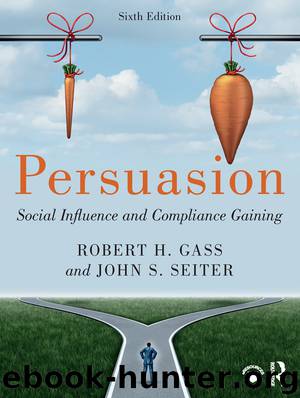Persuasion by Gass Robert H.; Seiter John S.;

Author:Gass, Robert H.; Seiter, John S.;
Language: eng
Format: epub
Publisher: Routledge
BOX 9.2 |
When Smoke Gets in Your Eyes: Inoculation Theory Applied
It’s clear from our discussion of inoculation theory that inoculation works effectively with messages that attack cultural truisms in laboratory settings. But how does the theory pan out when tested in “real-life” settings? First, Pfau, Van Bockern, and Kang (1992) argued that inoculation might be a good approach to use if you want to prevent young adolescents from smoking cigarettes. According to these researchers’ sources, more than 3,000 teenagers become smokers each day and, as a result, millions die of smoke-related diseases later in life. Because more than half of all smokers become “regulars” before high school, Pfau and colleagues (1992) conducted their study using seventh graders. The students were shown videos that (1) warned them that peer pressure might cause them to change their minds about smoking and (2) presented and refuted arguments that challenged the students’ attitudes about smoking (e.g., smoking is cool). Results showed that inoculation helped students resist smoking, but only if the students had low self-esteem. Interestingly, however, a follow-up study two years later found just the opposite: Inoculation worked for students with high self-esteem but not for those with low self-esteem (Pfau & Van Bockern, 1994). Thus, inoculation may wear off for those with low self-esteem, but there may be a sleeper effect for those with high self-esteem. Whatever the case, the authors argue that inoculating children against smoking must occur between elementary school and high school. After that, resistance strategies do not seem to work (Pfau & Van Bockern, 1994).
Second, Pfau, Kenski, Nitz, and Sorenson (1990) examined inoculation in political campaigns. These researchers noted that negative advertisements, in which one politician attacks another, are becoming more common and that one-third to one-half of all political ads may be negative. With that in mind, what should politicians do? One possibility is to inoculate voters; another is to wait until they are attacked and then refute the attacks. To test which strategy works best, Pfau and colleagues sent messages to voters during the 1988 presidential campaign. Voters received messages attacking their preferred candidate. Some of the voters were inoculated before being exposed to the attack message. Other voters, after being exposed to the attack message, received a message that refuted it. Results of the study found that an inoculation strategy worked the best. Those voters who had been inoculated were the least affected by the attack message.
In short, research has shown inoculation theory to be robust in applied contexts. Of course, given our space, we have only been able to scratch the surface here, but we hope you can imagine the wide array of contexts where an inoculation approach shows promise. For instance, recent research has detailed the ways in which inoculation might be used to defend people against conspiracy propaganda (Banas & Miller, 2013), deceptive advertising (Mason & Miller, 2016), and inoculation itself (Banas & Miller, 2013).
Download
This site does not store any files on its server. We only index and link to content provided by other sites. Please contact the content providers to delete copyright contents if any and email us, we'll remove relevant links or contents immediately.
The Secret History by Donna Tartt(18147)
The Social Justice Warrior Handbook by Lisa De Pasquale(11950)
Thirteen Reasons Why by Jay Asher(8445)
This Is How You Lose Her by Junot Diaz(6430)
Weapons of Math Destruction by Cathy O'Neil(5824)
Zero to One by Peter Thiel(5487)
Beartown by Fredrik Backman(5348)
The Myth of the Strong Leader by Archie Brown(5236)
The Fire Next Time by James Baldwin(5015)
How Democracies Die by Steven Levitsky & Daniel Ziblatt(4950)
Promise Me, Dad by Joe Biden(4907)
Stone's Rules by Roger Stone(4852)
100 Deadly Skills by Clint Emerson(4683)
A Higher Loyalty: Truth, Lies, and Leadership by James Comey(4546)
Rise and Kill First by Ronen Bergman(4542)
Secrecy World by Jake Bernstein(4387)
The David Icke Guide to the Global Conspiracy (and how to end it) by David Icke(4376)
The Farm by Tom Rob Smith(4320)
The Doomsday Machine by Daniel Ellsberg(4241)
